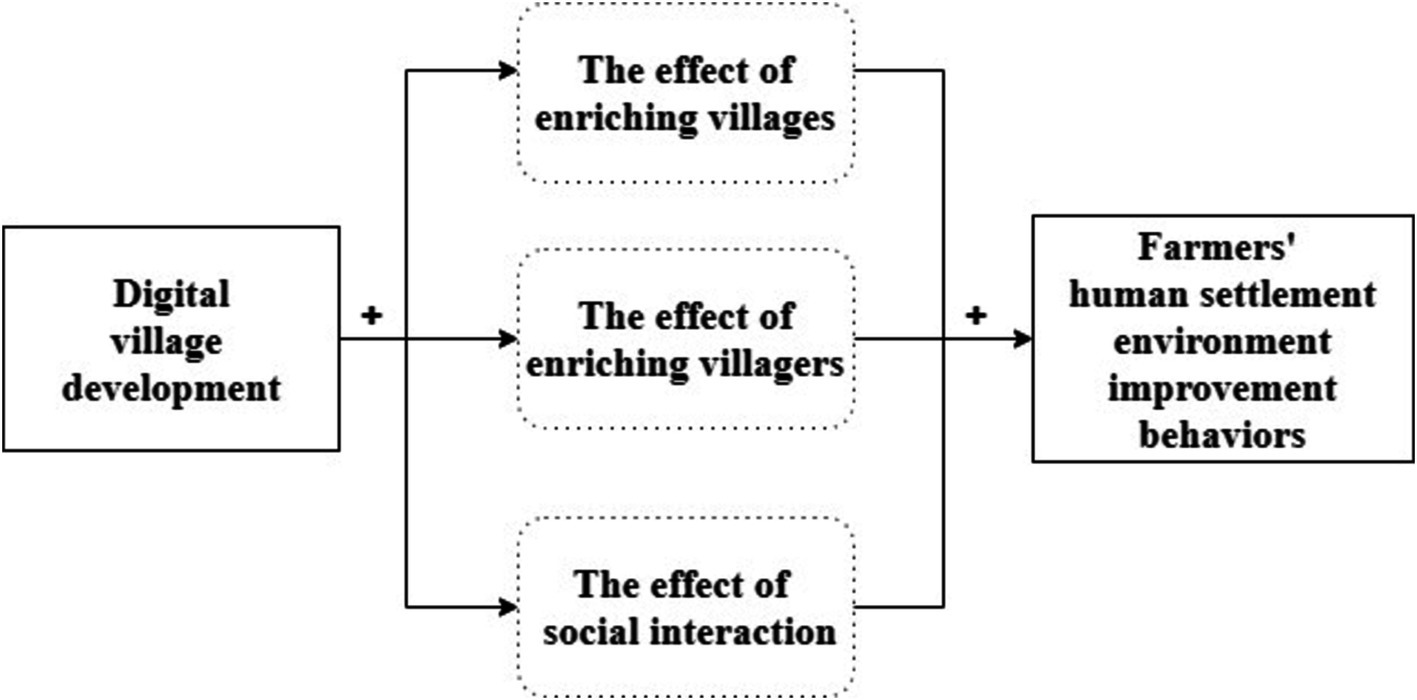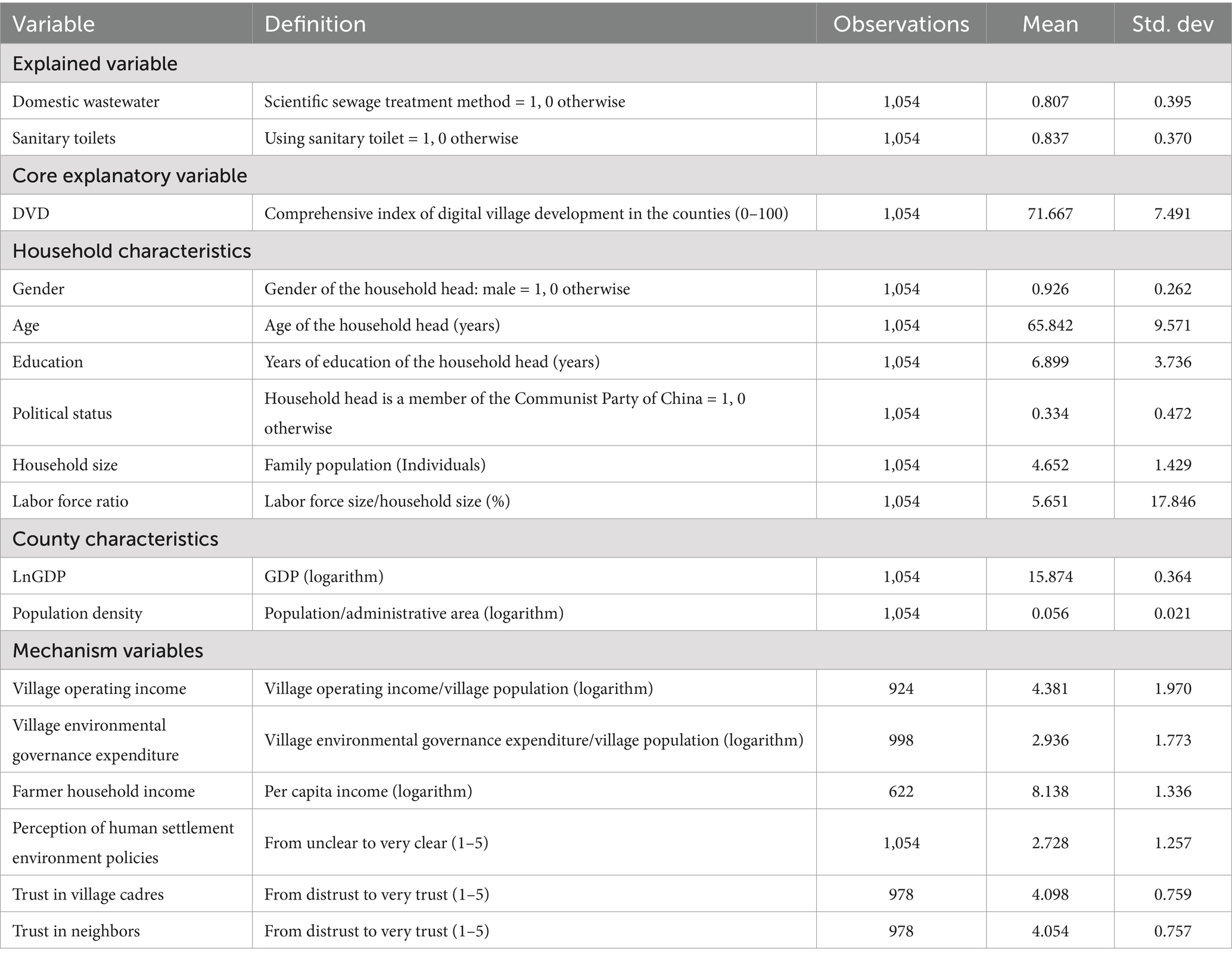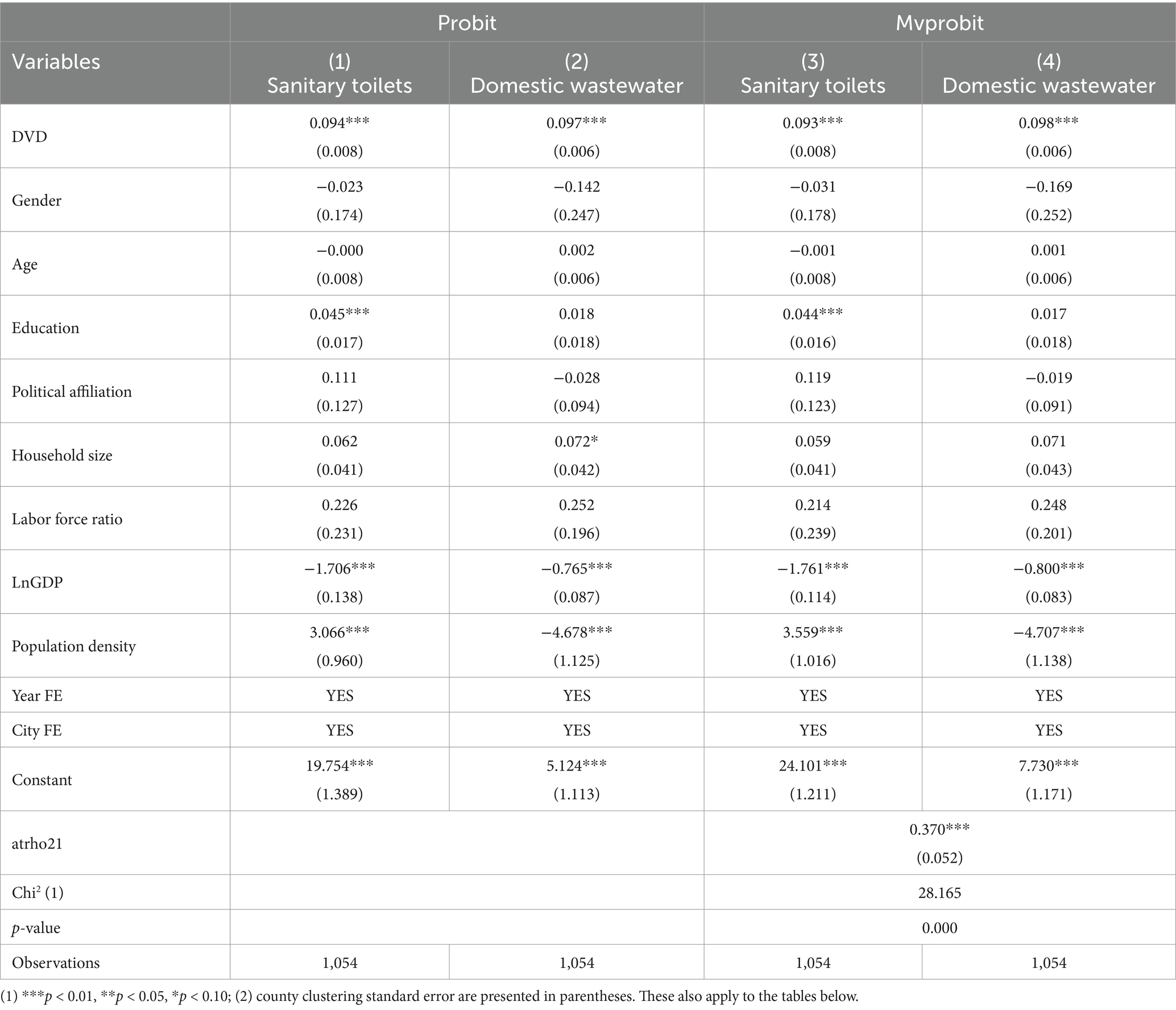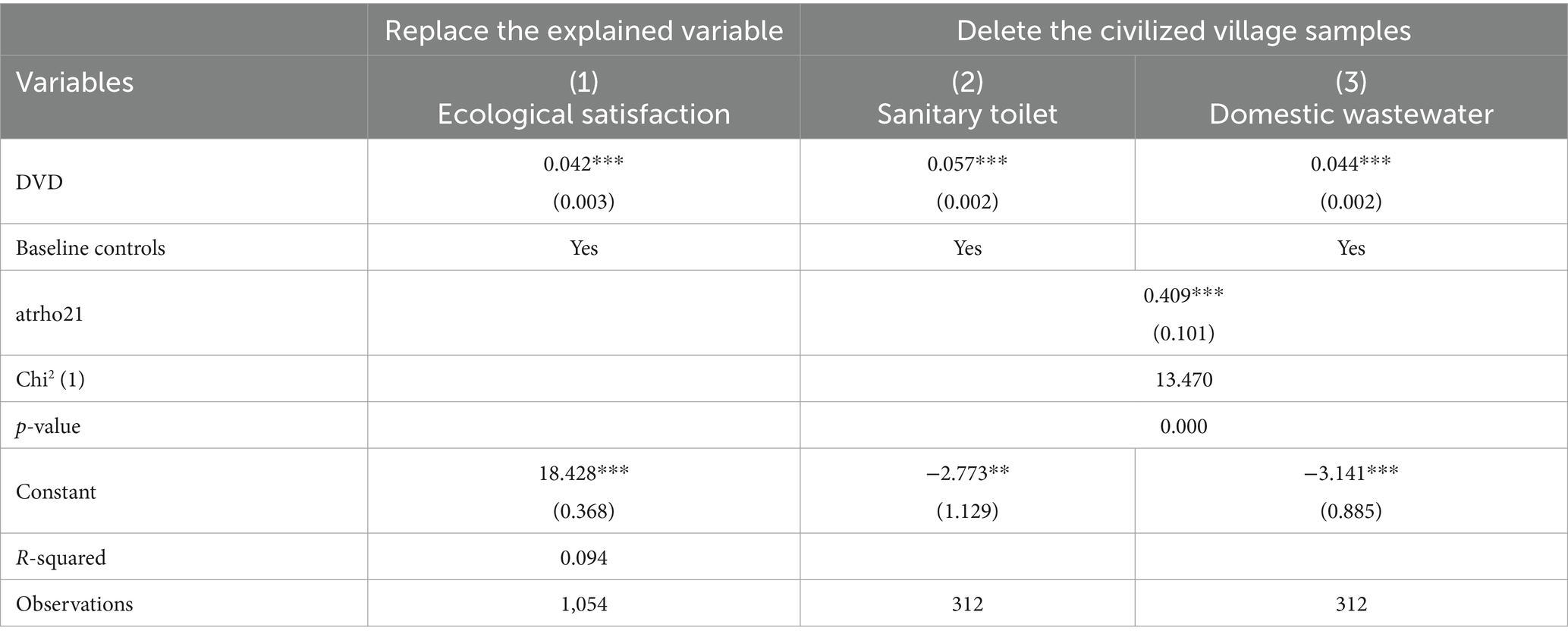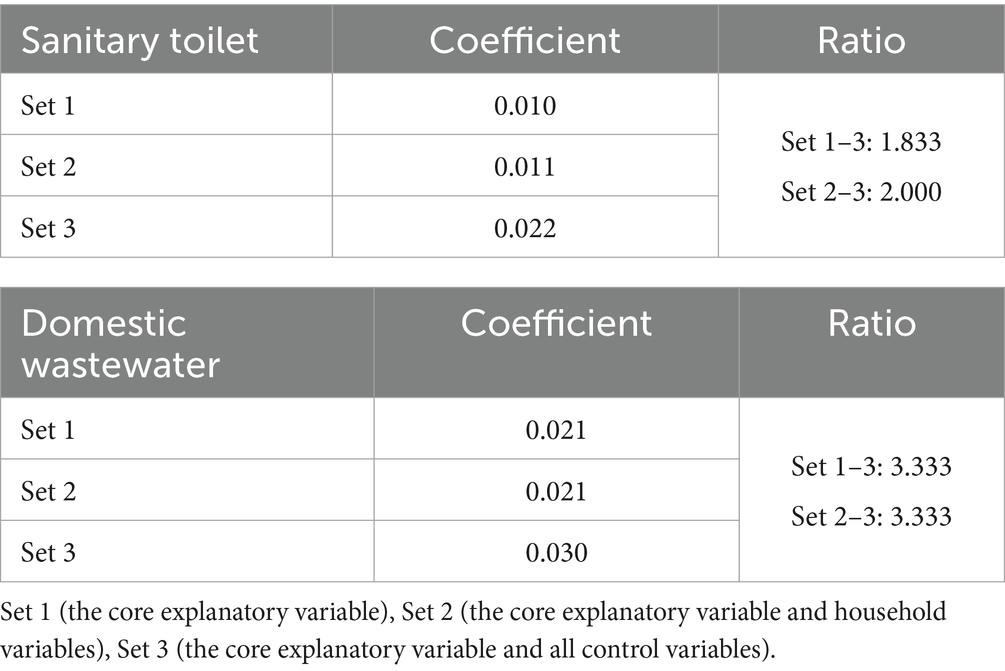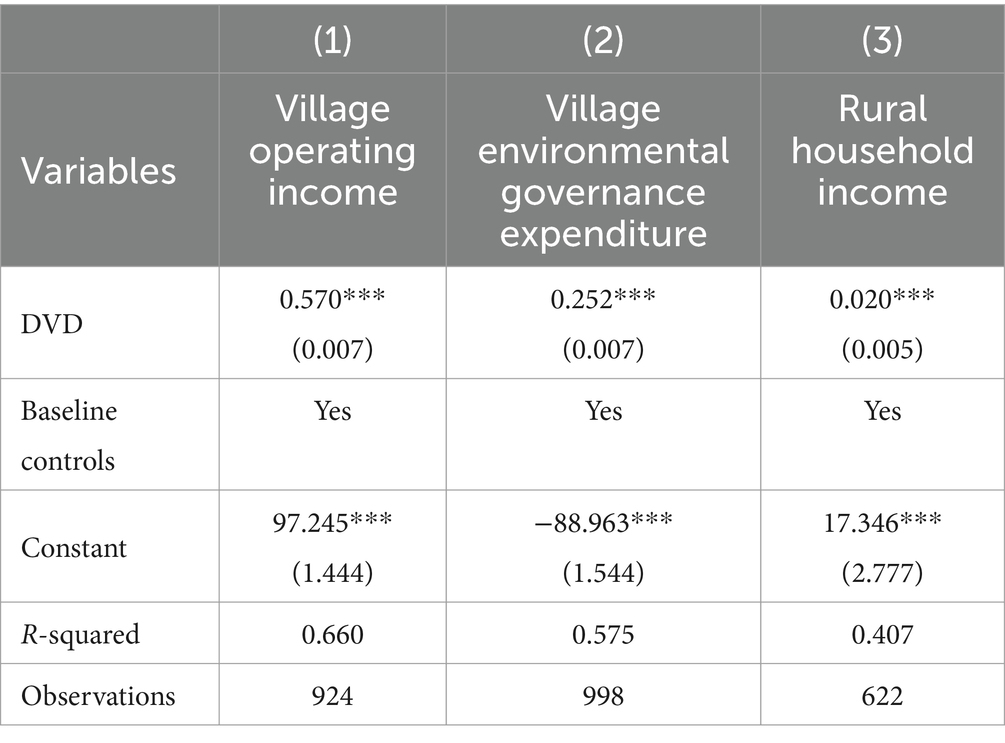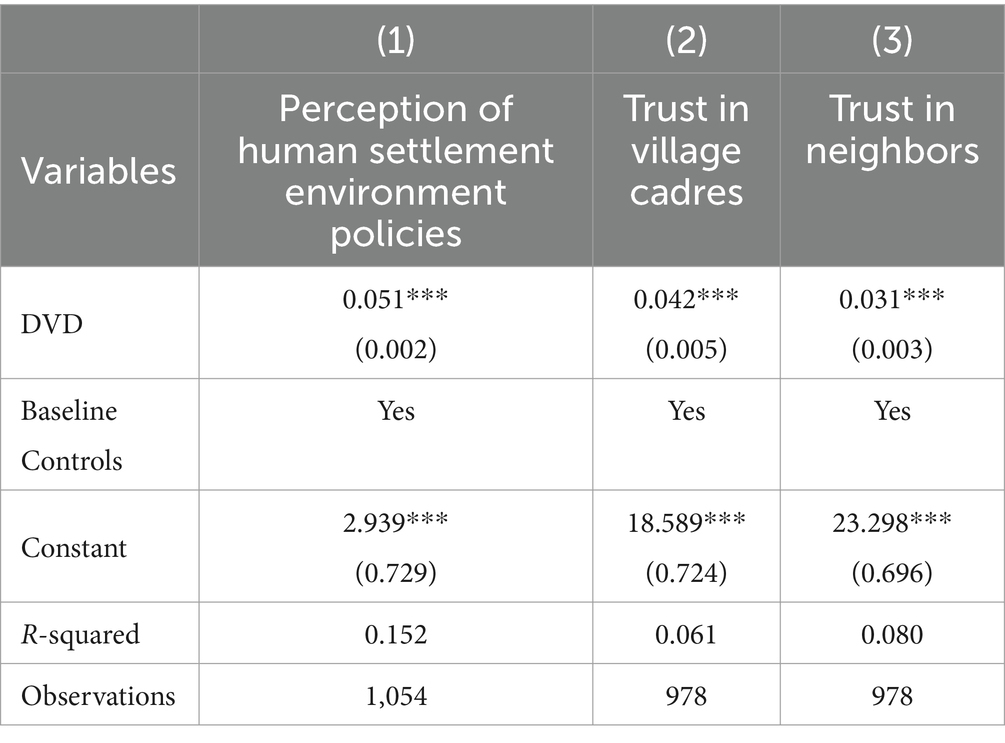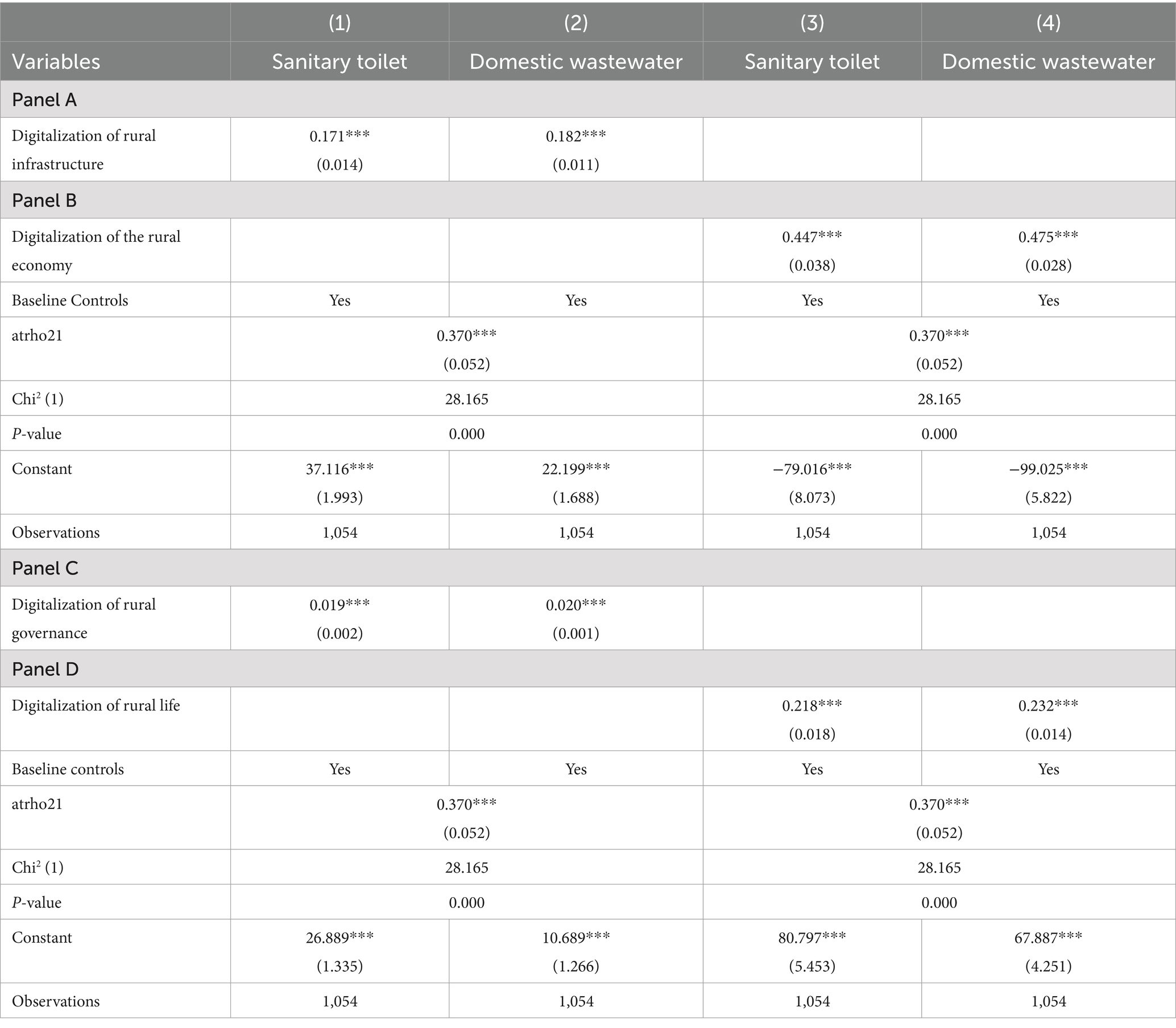- 1School of Law, Huazhong University of Science and Technology, Wuhan, China
- 2Institute of Agricultural Economics and Development, Jiangsu Academy of Agricultural Sciences, Nanjing, China
Introduction: As digital village construction advances, digital technologies are gradually permeating various aspects of rural life, providing a new avenue for improving rural human settlement environment (RHSE).
Methods: We matched the 2020 and 2021 data from the China Land Economic Survey (CLES) with the County Digital Rural Index (CDRI), exploring how digital village development (DVD) influences farmers’ human settlement environment improvement behaviors (HSEIBs).
Results and discussion: Research findings indicate that DVD has significantly increased farmers’ probability of disposing of domestic wastewater scientifically and adopting sanitation toilets, with robustness checks conducted. Further analysis reveals that this positive impact is primarily realized through effects of enriching villages, enriching villagers and social interaction. The analysis of heterogeneity reveals that in households with a higher proportion of seniors, DVD significantly raises the usage of sanitation toilets but does not significantly promote the scientific treatment of domestic wastewater. Additionally, when we subdivide DVD into different dimensions, we find that the digitalization of rural infrastructure, rural economy, rural life and rural governance can effectively facilitate farmers’ HSEIBs, but the digitalization of rural governance has the least impact. Our findings not only enrich the field of digital well-being research but also shed light on the digital divide problem in rural China.
1 Introduction
The Sustainable Development Goals (SDGs) clearly articulate a vision to build inclusive, safe, resilient and sustainable cities and human settlements by 2030 (United Nations Development Programme [UNDP], 2015). Compared to urban areas that gather large populations and wealth, rural communities receive significantly less attention within the SDGs framework (Lowery et al., 2020). As a weak link in the development of human communities, rural human settlements face multiple challenges, including disorderly spatial layouts (Wu et al., 2022), inadequate provision of public service facilities (Victor et al., 2022) and severe ecological pollution (Hu et al., 2022). Taking China’s wastewater treatment as an example, the treatment rate for urban and county-level cities exceeded 96% in 2022 (Ministry of Housing and Urban-Rural Development [MHUD], 2023), while the treatment rate of domestic wastewater in rural areas is only around 31% (State Council of the People’s Republic of China [CPG], 2023). The backward RHSE not only seriously endangers the health of rural residents (Hammer and Spears, 2016; Jeremy et al., 2022), but also greatly diminishes their sense of happiness (Li et al., 2023). Therefore, improving RHSE has become a pressing challenge that must be addressed to achieve the SDGs.
The existing literature mainly discusses the paths of improving RHSE from the perspective of actors and their relationships, such as government management models (Zhang and Guo, 2023), villagers’ self-governance models (Sheng and Ma, 2023) and multi-stakeholder collaborative governance models (Zhang Y. et al., 2024), but cannot fundamentally address the issue of insufficient farmer participation (Zhang and Liu, 2023). With the continuous deepening of digital village construction, information technology, digitization and intelligence have been widely applied in rural areas. This not only promotes the upgrading of the agricultural industry, stimulates the vigorous development of the rural economy, but also accelerates the dissemination of rural culture, innovates the rural governance model and profoundly changes the lifestyle of farmers (Salemink et al., 2017; Malik et al., 2022). Under the comprehensive promotion of DVD, new opportunities are provided for farmers to participate more actively in improving RHSE. Through digital means such as “Internet+,” big data, cloud computing and artificial intelligence, it is expected to solve the difficulties in mobilization, participation, supervision and data statistics in traditional governance. This would provide more efficient and intelligent strategies for optimizing farmers’ HSEIBs.
The role of digital technology in rural governance is becoming increasingly significant, and some studies have begun to explore the application of digital technology in farmers’ HSEIBs. Li Z. et al. (2024) found that farmers using information and communication technology can reduce information acquisition costs and increase expected health well-being, thereby promoting rural households to carry out toilet hygiene renovations. Through examples of using WeChat groups and public accounts, Zhang Y. et al. (2024) also demonstrated how digital technology can promote farmers’ HSEIBs by promoting a multi-center governance model. However, these studies focus on a single dimension of DVD, failing to fully capture its overall impact as a comprehensive information technology on farmers’ HSEIBs. In addition, Liu et al. (2023) used provincial panel data to find that the digital economy has significantly improved the quality of RHSE. But this study did not deeply explore the environmental benefits brought by DVD. Compared to the provincial-level digital economic development, the DVD Index is a key indicator for measuring the level of digital development in villages, which focuses on ensuring that rural residents can access and apply digital technologies conveniently, providing a more intuitive perspective for understanding the impact of digitalization.
China provides an ideal research scenario for exploring the relationship between DVD and farmers’ HSEIBs. The Chinese government has actively implemented a series of strategic measures to accelerate DVD. According to the CDRI Report (China Institute for Rural Development of Peking University [CIRDNC], 2022) published by Peking University, the CDRI increased from 50 points in 2018 to 55 points in 2020. As of June 2022, the number of rural internet users had reached 293 million and the rural internet penetration rate had reached 58.8%, nearly double the level in 2015 (Ministry of Agriculture and Rural Affairs of China [MARA], 2023). At the same time, farmers’ HSEIBs are also continuously better. The coverage rate of sanitary toilets in rural areas has increased from less than 60% in 2018 to 77.5% in 2022 (People’s Daily, 2021; CNS, 2022). And the rate of rural domestic sewage treatment has also increased from 25.5% in 2020 to about 31% in 2022 (State Council of the People’s Republic of China [CPG], 2023). Therefore, exploring how farmers’ HSEIBs can benefit from the digitalization process is a key issue that this study aims to solve.
Based on the data from the CLES and the CDRI, we examined whether DVD contributes to farmers’ HSEIBs in terms of sewage treatment and the use of sanitary toilets. Given the characteristic of farmers’ HSEIBs, we, respectively, analyzed the impact mechanism of DVD on HSEIBs from two dimensions: economic and social interactions. The former includes the financial status of village collectives and farmers’ income, while the latter focuses on farmers’ perception of policies, the leadership of village cadres and the level of trust among villagers. Moreover, based on the digital divide and the secondary indicators of the CDRI, we discussed the heterogenous impacts of DVD.
Compared to existing literature, this paper’s marginal contribution mainly lies in four aspects. Firstly, in terms of research subject, we focus on the theoretical logic underlying HSEIBs empowered by digital ways. This enriches research on rural environmental issues, providing feasible solutions for tackling rural pollution. Secondly, from a research perspective, few studies have focused on the environmental effects of DVD. We innovatively examine the dividend effect of DVD on farmers’ HSEIBs, providing empirical evidence to the current research in the field of DVD. And we also measure the level of DVD based on the county level and combine CLES data to provide micro support for HSEIBs, which supplements the previous research focusing on the macro level of provinces and cities. Thirdly, in the construction of the research framework, based on the theory of club goods and collective action characteristics, we reveal how DVD promote farmers’ HSEIBs through three aspects: enriching villages, enriching villagers and social interaction. In addition, we no longer treat the level of DVD and different household groups as homogeneous units, but have conducted in-depth discussions separately, providing more refined guidance for future policy practices.
The remaining structure of the paper is as follows. Section 2 defines the attribute of farmers’ HSEIBs and constructs the theoretical framework. Section 3 outlines the data sources, variable selection, and the application of the model. Section 4 presents the empirical findings and discusses their implications. Lastly, Section 5 comprises conclusions and policy implications.
2 Theoretical analysis and research hypotheses
2.1 The characteristic of farmers’ HSEIBs
To stimulate farmers’ HSEIBs, it is necessary to clearly know the attribute of RHSE. Firstly, RHSE is a communal and collective public good, and its public good attribute determines that transaction costs are higher and property rights are difficult to determine (Li et al., 2021). Secondly, the funding for promoting farmers’ HSEIBs is raised through a joint payment system between the public and private sectors, demonstrating the club goods characteristics of a “two-part tariff” (Feldstein, 1972; Zhang F. et al., 2024). Specifically, the “two-part tariff” theory advocates separating the annual membership fee from the cost of purchasing club goods, thereby reducing free-rider behavior and improving the efficiency of public good provision. In the case of household toilet hygiene renovation and sewage treatment, the public sector is responsible for constructing wastewater disposal infrastructure, providing farmers with the prerequisite conditions for scientifically treating wastewater and transforming their toilets for hygiene. And farmers must bear the cost of connecting household pipelines to the public wastewater system and acquiring necessary ancillary equipment. In the “two-part tariff” model, whether increasing village-level public investment in the “first part” or improving household income in the “second part” can significantly promote households to properly manage domestic wastewater and use sanitary toilets (Shao et al., 2024). In addition to economic factors, according to behavioral mimicry theory, farmers’ HSEIBs are also influenced by social factors, including their own perception of policies and the influence of surrounding individuals (Lede et al., 2019; Sun et al., 2020).
2.2 Mechanism analysis of DVD on farmers’ HSEIBs
Based on previous Chinese data, it suggests that there may be a positive correlation between DVD and farmers’ HSEIBs. So, how does DVD influence farmers’ HSEIBs? By incorporating the attributes of farmers’ HSEIBs, we discussed the three theoretical mechanisms, including effects of enriching villages, enriching villagers and social interaction. The theoretical framework of this study is shown in Figure 1.
2.2.1 The effect of enriching villages
With the advancement of digital rural construction, the digitization of rural areas drives to the prosperity of economic activities in rural areas, thereby strengthening the rural collective economy. One is the effect of factor convergence. On the one hand, it improves the efficiency of factor allocation. As data, information and other new production factors integrate into agricultural systems, they not only reconfigure the composition of production factors but also enhance the synergistic development efficiency of these elements, thus breaking the time and space constraints of rural economic development (Malik et al., 2022). For example, by leveraging digital information technology to explore the digital potential of local rural resources and activate collective rural resource assets, a solid foundation has been laid for the development of collective economy. On the other hand, it guides the flow of resource elements to rural areas. Digital village construction promotes bidirectional flow of urban and rural elements, exhibiting a strong agglomeration effect on financial resources, talents, technology and other factors in rural areas as well as their surrounding regions (Zhou et al., 2023). From 2012 to the end of 2022, the cumulative number of people returning to their hometowns to start businesses reached 12.2 million (People’s Daily, 2023).
The other is the effect of industrial transformation. Empowered by digital technologies such as the Internet, the format, originally dominated by agricultural production and operation, gradually extends to the second and third industry-related sectors (Liu et al., 2023). This leads to the emergence of new formats such as agricultural tourism, agricultural product processing, rural e-commerce and innovation in the development model of collective economy. Furthermore, the free flow and optimal allocation of information, resources and talents have ultimately enhanced the endogenous driving force of rural collective economic development.
The better the development of collective economy in a village, the more obvious the effect of farmers’ HSEIBs. Collective economy is the main source of public investment in improving RHSE. Its vigorous development enhances the financial strength of villages and promotes the improvement of public sewage infrastructure, thus providing a material basis for farmers’ HSEIBs, solving the “first part” investment problem (Shao et al., 2024). Moreover, the development of collective economy can strengthen farmers’ identification and support for the collective. This fosters a sense of belonging and collective pride among farmers, encouraging them to more actively engage in improving RHSE (Zhang F. et al., 2024).
2.2.2 The effect of enriching villagers
Digital village construction, in optimizing rural resource allocation and driving structural upgrading, presents advantageous conditions for farmers’ income increase. Firstly, the proliferation of digital infrastructure such as smartphones and internet-connected computers can lower the learning costs for farmers, thereby providing a favorable digital environment for rural industrial development and agricultural household livelihood diversification. Secondly, the promotion of smart agriculture can significantly increase agricultural productivity, reduce production costs and increase farmers’ income (Kaila and Tarp, 2019). At the same time, it can promote farmers’ income in the circulation link. The rise of rural e-commerce can not only promote online sales of agricultural products but also reduce intermediate links in sales, thereby increasing product prices (Wei et al., 2024). Thirdly, the integration of digital technologies with rural industries will give birth to new formats, creating more non-agricultural employment opportunities for farmers (Min et al., 2020) and directly boosting their wage income. Fourthly, the development of digital inclusive finance such as digital payments and online lending can reduce the cost for rural businesses to access financial resources (Yu et al., 2024) and provide strong credit support for increasing farmers’ income. Furthermore, DVD will facilitate the development of collective economy. By holding shares in collective economic enterprises, farmers can reap the dividends from the development of collective economies, thereby enhancing their property income.
Family income levels constitute a pivotal determinant for farmers’ HSEIBs. On one hand, as income rises, it is invariably accompanied by an escalated demand for superior living environments. This prompts rural households to take actions to improve RHSE (Zheng et al., 2024). On the other hand, an increase in income would enhance family capacity for investments in ambient habitat facilities, enabling them from “desiring to do” to “being able to” (Li Z. et al., 2024).
2.2.3 The effect of social interaction
Rural China is a familiar society formed by kinship and geographical relationships. In addition to being constrained by formal institutions such as laws and regulations, farmers’ HSEIBs are also influenced by informal institutions, especially policy perceptions, village cadres and surrounding communities. The inclusiveness of digital information will erode the existing hierarchical structure, change the government-dominated situation in rural governance and promote the formation of a decentralized, more open and equal social interaction network, thus injecting new vitality into improving RHSE.
From a perspective of farmers’ perceptions of policies, digital technology, will break down information barriers, increase opportunities for information acquisition and facilitate farmers’ understanding of RHSE policies. On one hand, digital technologies can narrow the information gap between local governments and the public. The village committee can publish policy promotion videos through Apps or WeChat groups, allowing villagers to comprehend the latest policies on RHSE in a simple and accessible manner. This would enhance their environmental awareness, thereby enhancing their expectations for household waste water treatment and toilet renovations. On the other hand, the popularity of smart devices enables farmers to independently collect information related to RHSE, enhancing farmers’ subjective initiative to improve RHSE (Chen et al., 2023). Existing studies show that the stronger the policy perception, the higher their intention to participate, and the more active their participation behavior (Sun et al., 2020; Grilli and Curtis, 2021).
From the perspective of village cadres, digital empowerment promotes the standardized construction of village committees by leveraging innovative governance models such as “Internet + Government Services initiative,” “Internet + Village Affairs,” “Internet + Education” and “Internet + Medical Care.” These models significantly enhance the efficiency of multi-functional service operations in villages and strengthen the leadership capabilities of village cadres. Existing studies have shown that improving village cadres’ leadership can enhance villagers’ trust in them, thus effectively promoting farmers’ HSEIBs (Liu et al., 2022; Yi et al., 2024). Village cadres are organizers and guides for farmers’ HSEIBs. They actively mobilize farmers to scientifically treat sewage and use sanitary latrines through organizing village meetings and conducting publicity activities. At the same time, village cadres play a leading role in participating in public affairs. Through their exemplary behavior in environmental improvement, village cadres can encourage surrounding farmers to improve RHSE (Zhang F. et al., 2024).
In the context of rural acquaintance society, “face-to-face supervision and criticism” may damage interpersonal relationships and increase the emotional burden of farmers’ HSEIBs, potentially becoming a barrier to their active involvement in environmental governance (Zhang Y. et al., 2024). Fortunately, with the anonymous supervision mechanism of online social platforms, it is possible to effectively avoid the awkwardness and conflict caused by traditional face-to-face governance models. On online platforms, villagers can supervise each other while maintaining anonymity. This does not prevent them from supporting each other, interacting frequently and building a sense of trust. This trust, in turn, enhances their mutual dependence and interaction frequency (Huxman and Vangen, 2005). Trust not only helps reduce the costs of management and supervision but also promotes the flow of information between different organizations (Edelenbos and Klijn, 2007; Yuriev et al., 2020). Ultimately, this will contribute to shaping and maintaining the ethical norms and social order of villages, reducing violations in improving RHSE.
Hence, the following hypotheses are proposed:
H1: DVD can significantly improve farmers’ HSEIBs.
H2: DVD promotes farmers’ HSEIBs by fostering village collective economic.
H3: DVD promotes farmers’ HSEIBs by increasing their income.
H4: DVD promotes farmers’ HSEIBs by fostering their policy perception, trust in village cadres and neighbors.
3 Materials and methods
3.1 Source of data
The research data used in this article is sourced from the CLES and the CDRI jointly released by CIRDNC and Alibaba Research Institute. We ultimately selected the 2020 and 2021 CLES data, as well as the corresponding CDRI data for the study.
The CLES is conducted by Nanjing Agricultural University in Jiangsu Province, covering aspects like agricultural production, household welfare and participation in public affairs. The survey uses the PPS sampling method, first selecting two counties from each city and then selecting households from two administrative villages in each county. Given the significant economic disparities in the northern, central and southern regions of Jiangsu Province, the CLES sample is nationally representative (Chen and Ye, 2024). The CDRI database presents the development of digital rural areas in Chinese counties, including the comprehensive index of DVD, four secondary indicators and multiple tertiary indicators. For research purposes, we matched these two databases based on the county address information and removed samples with missing data for key variables, resulting in 1054 observations of farm households.
3.2 Variables selection
The dependent variable is farmers’ HSEIBs. The treatment of domestic sewage and the use of sanitary toilets are key priorities of RHSE. Based on existing research (Shao et al., 2024; Zhang F. et al., 2024), we measure farmers’ HSEIBs from the two aspects of scientifically treating domestic sewage and using sanitary toilets. Specifically, methods of domestic wastewater treatment primarily include discharging into sewers, using dedicated containers for collection, and direct discharge. We define the method of directly discharging domestic wastewater as non-scientific treatment, while other methods are considered scientific treatment. Regarding the use of sanitary toilets, if a farming household has a toilet with harmless treatment capabilities, it is considered that they are using a sanitary toilet; otherwise, it is regarded as not using one.
The core explanatory variable is DVD. We adopt the “comprehensive Index for Digital Village Development” to represent it. In addition, in the exploration of heterogeneity, we also selected four secondary indicators for analysis, including the “Rural Infrastructure Digitalization Index,” “Rural Economic Digitalization Index,” “Rural Governance Digitalization Index” and “Rural Life Digitalization Index.”
For control variables, we refer to existing studies (Sun et al., 2020; Li et al., 2021; Li Z. et al., 2024) and research objectives and select the following: household characteristics, including the gender, age, education level and political status of the household head; family characteristics including family size and the proportion of family labor force; county-level characteristics, including per capita GDP and population density. Notably, in China, the political status of whether one is a Party member will affect their leading role in HSEIBs (Zhang Y. et al., 2024).
Mechanism variables include three aspects. The first is the development of village collective economy, represented by per capita operating income and per capita environmental governance expenditure in the village. The second is household income, represented by the logarithm of per capita household income. The third is social interaction variables, including farmers’ policy perception, village cadres’ leadership and trust among villagers, measured by farmers’ understanding of RHSE policies, farmers’ trust in village cadres and farmers’ trust in neighbors, respectively.
3.3 Model construction
The empirical work mainly estimates the impact of county DVD on farmers’ HSEIBs. HSEIBs in this study are binary dummy variables, and the Probit model is often used. However, the efficient operation of sanitation toilets typically relies on the availability and functionality of supporting public sewage infrastructure. Therefore, the toilet renovation in rural areas is seamlessly integrated with domestic wastewater treatment. Estimating the two behaviors of domestic wastewater treatment and sanitary toilet use separately using a Probit model fails to accurately capture their interaction and does not allow for effective comparison (Zhang F. et al., 2024). Considering the interrelationship between two types of HSEIBs, we adopt Multivariate probit (Mvprobit) models that can simultaneously handle multiple binary choices. The models are specified as follows:
For the dependent variable, the equation can be set as:
In Equations 1–3, =1 and =0 indicate, respectively, that farmers adopt or do not adopt the behavioral change in RHSE. and denote, respectively, whether farmers use a sanitary toilet and whether they scientifically treat domestic wastewater. is the core explanatory variable for the digital village development level of the county. represents a series of control variables. denotes fixed effects for cities. denotes fixed effects for years. is the constant term. is an error term that follows a multivariate normal distribution with zero means and unit variances. By maximizing the likelihood function in the above equation, we can obtain the estimated parameter .
Then, to validate effects of enriching villages, enriching villagers and social interaction, we construct the linear Ordinary Least Squares (OLS) model, as follows:
In Equation 4, represents the per capita operating expenditure and per capita environmental governance expenditure of the village where household is located, as well as the per capita household income of household . Additionally, it encapsulates the policy perception, trust in village cadres and trust in neighbors of farmer . is a constant term. is the random error term, and are the parameters to be estimated. The meanings of the other symbols are roughly the same as in Equation 1.
In the application of OLS models, two points need to be clarified. First, given that the income and expenditure variables are continuous, we decided to use the OLS model. Prior to formally applying the OLS model, we conducted preliminary regression analyses on the income and expenditure variables separately and confirmed that these variables meet the prerequisites of the OLS model, which specifically include linearity, independence of observations, normal distribution of residuals, homoscedasticity, and the absence of multicollinearity. Second, regarding the variables related to social interaction mechanisms, they fall into the category of ordinal categorical variables. Ordinal logit models are typically an appropriate choice for such variables. However, following the study by Güneri et al. (2022), it is necessary to verify the proportional odds assumption before using ordinal logit models. Unfortunately, our data did not pass this test, and even when attempting to use a generalized ordered logit model with relaxed assumptions, the regression results failed to converge. Therefore, we opted to use the OLS model for validation. The reason is that, when the dependent variable is ordinal, if the model is correctly specified, the econometric regression results from the OLS model, including the coefficients and their significance levels, are substantively not significantly different from those obtained through an ordinal logit model (Ferrer-i-Carbonell and Frijters, 2004). Similarly, we also conducted regression analyses on the variables related to policy perception and trust, and confirmed that they satisfy the prerequisites of the OLS model.
Descriptive statistics of the main variables in the empirical analysis are shown in Table 1. Meanwhile, to visually observe the positive correlation between DVD and farmers’ HSEIBs, we conducted comparisons of differences between groups. The results are presented in Table 2. Overall, the results are as expected. However, these results have not considered the interference of other factors and thus require further empirical analysis. It is worth noting that the test between groups for using sanitary toilet did not pass, which indirectly reflects the necessity of establishing the Mvprobit model. That is, the use of sanitary toilet relies on the establishment of a sewage system.
4 Results and discussion
4.1 Baseline regression analysis
Table 3 reports the impact of DVD on farmers’ HSEIBs. Columns (1) and (2) report the estimation results of Probit models, while columns (3) and (4) report the estimation results of the Mvprobit regression. Mvprobit models revealed that the correlation coefficient between farmers’ use of sanitation toilets and domestic wastewater treatment was 0.370, significant at the 1% level. This suggests a strong association between farmers’ HSEIBs, indicating that the adoption of sanitary toilets is often accompanied by the scientific treatment of domestic wastewater. Regression results in columns (3) and (4) show that DVD significantly increases the probability of scientifically treating domestic wastewater and using sanitary toilets. Based on the above analysis, H1 is confirmed.
According to the results of controlling variables, households with a higher level of education are more likely to use sanitary toilets, which is consistent with previous research findings (Sun et al., 2020). The reason lies in two main aspects. On the one hand, individuals with higher education levels possess more health knowledge and have a deeper understanding of the health risks associated with not using sanitary toilets. On the other hand, they generally have a stronger awareness of environmental protection and sustainable development, and are more clearly aware of the negative impacts that unhygienic waste disposal can have on the environment. Therefore, they are more likely to choose environmentally friendly sanitation facilities. In addition, the estimated coefficient of per capita GDP at the county level is significantly negative. This may be due to some regions prioritizing GDP growth while neglecting environmental protection (Duan et al., 2024), lacking public investment in environmental governance, which is not conducive to HSEIBs.
4.2 Robustness test
Firstly, replacing the dependent variable. We use “farmers’ satisfaction with the ecological livability of their village” as a substitute variable for farmers’ HSEIBs. This is because if DVD improves RHSE, it will ultimately enhance farmers’ satisfaction with the ecological livability of their village. Given that the categorical variable did not satisfy the parallel regression assumption of the ordinal probit model, but did meet the prerequisites of the OLS model, we chose to use the OLS model for regression analysis. Secondly, eliminating potential sources of interference. Farmers’ HSEIBs may be influenced by the level of village development. For instance, villages that have been awarded the title of “Civilized Village” generally possess a higher level of ecological civilization construction, which in turn encourages farmers’ actions to be more environmentally friendly. Thus, we exclude the sample of civilized villages. The empirical estimation results are shown in Table 4. The estimated coefficients of DVD are all positive and statistically significant. In conclusion, the results of the benchmark regression can be considered robust.
Although a range of control variables were selected in the baseline regression, there may still be potential omitted variable bias. Thus, we conducted an omitted variable bias test. Specifically, based on the sensitivity analysis used in existing studies (Aidt and Franck, 2015; Li X. H. et al., 2024), the Ratio coefficient is constructed to identify the strength of bias caused by unobservable variables through observable variables. The Ratio coefficient is constructed as follows: and represent the estimated coefficients of the core explanatory variables under all possible control sets and finite variable sets, respectively. When , it can be considered that the selected observable variables have strong explanatory power and potential omitted variable bias can be ignored.
Due to the complexity of the probit model, the OLS model can be used here to estimate the ratio parameter. As shown in Table 5, the minimum Ratio value calculated for different sets is 1.833, indicating that if the interference of omitted variables is considered, the explanatory power is at least 1.83 times that of the selected control variables. Therefore, it can be considered that the impact of omitted variables on the regression results is relatively small.
4.3 Mechanism test
As evidenced by theoretical analysis, DVD can promote farmers’ HSEIBs through effects of enriching villages, enriching villagers and social interaction. Based on Equation 4, we further conduct empirical analysis and the regression results are shown in Tables 6, 7. It is worth noting that some mechanism variables are missing, so the regression sample and the benchmark regression are not completely consistent.
In Table 6, the impact coefficients of DVD in columns (1)–(3) are all positive and have passed the significance test. With the advancement of DVD, the financial strength of villages has been enhanced, which has led to an increase in public expenditure on environmental governance in villages, meaning the “first part” investment in RHSE. At the same time, DVD also creates favorable conditions for increasing farmers’ income, providing a foundation for the “second part” investment. Therefore, H2 and H3 are verified.
Table 7 columns (1)–(3) report the estimated results of DVD on policy perception, trust in village cadres and trust in neighbors, with coefficients of 0.045, 0.060 and 0.042, respectively, all passing the significance test at the 1% level. Thus, H4 is confirmed.
Existing studies mostly focus on social interaction mechanisms. For example, Liu et al. (2022) and Yi et al. (2024) explore how to promote farmers’ HSEIBs, from the perspectives of village cadres’ public service motivation and leadership. Sun et al. (2020) investigated the willingness and behavior of farmers to improve RHSE from the dual perspectives of social norms and social supervision. Unlike previous studies, our analysis is grounded in the “two-part tariff” model for RHSE, which reflects both club goods’ characteristics and the collective action dynamics. It not only embraces the social interaction mechanisms highlighted in prior research, but innovatively examines economic mechanisms, thereby offering a more comprehensive perspective.
4.4 Heterogeneity analysis
4.4.1 The digital divide dimension
Farmers’ HSEIBs face constraints due to factors such as low digital literacy and limited access to information. Influenced by traditional production and lifestyle for a long time, the elderly population in rural areas faces shortcomings in information access, which limits their acceptance and application of digital technology (Chen et al., 2023). At the same time, the insufficient digital literacy of elderly residents further exacerbates the digital divide, making it difficult for them to fully enjoy the benefits of the digital age, thereby reducing their attention to RHSE (Liu et al., 2023).
We defined individuals aged 60 and above as seniors, and classified households based on the proportion of senior citizens in each household. Subsequently, we conducted regression analysis, the results of which are presented in Table 8. It is not difficult to discern that in households with a relatively low proportion of elders, DVD has significantly increased the probabilities of both types of HSEIBs. However, in households with a higher proportion of elderly people, DVD only has a significant impact on the use of sanitary toilets and does not significantly promote the scientific treatment of domestic sewage. The possible reason is that, the promotion of rural toilet improvement as a nationwide activity is not influenced by the degree of aging. On the other hand, there is no mandatory requirement for domestic sewage treatment and under the economic burden and cognitive limitations caused by aging, rural households have a relatively low willingness to treat domestic sewage (Zhang F. et al., 2024). These findings highlight the challenges faced by the elderly population in the rural digitalization process, which are in line with existing research conclusions (Wang et al., 2023; Wei et al., 2024). For rural seniors, barriers in the application of digital technologies stand out and future policies must focus on addressing this issue.
4.4.2 The dimension of digital rural development
Although the basic regression analysis has verified the positive effects of DVD on farmers’ HSEIBs, further exploration is needed to assess the impact of various dimensions of DVD, with a view to better advancing digital village construction. We employed four secondary indicators of DVD as core explanatory variables to regress on farmers’ HSEIBs.
The results are shown in Table 9. The four secondary indicators of DVD can significantly promote farmers’ HSEIBs, all passing the 1% significance test. However, the impact coefficient of digital village governance is several times smaller than that of the other three dimensions. Potential reasons may include two aspects: First, the digitalization of rural infrastructure has built a bridge connecting rural areas to the outside world, promoting the widespread application of digital technology in daily life (Salemink et al., 2017; Meyn, 2020). This not only enhances the digital literacy of farmers but also provides a solid foundation for the vigorous development of rural digital economy, thereby promoting the “two-part investment” in RHSE. Second, the digitalization of rural governance is mainly reflected in the optimization of administrative processes and the improvement of service quality (Chen and Ye, 2024), but specific measures directly related to RHSE, such as the construction and maintenance of sewage infrastructure, toilet pipeline maintenance, have not been its focus.
Therefore, policymakers should pay high attention to the balanced development of various aspects, especially increasing investment and guidance in the digitalization of rural governance related to RHSE, to ensure the comprehensiveness and effectiveness of DVD when promoting the digital rural strategy.
5 Conclusion and implications
As digital village construction progresses, digital technology presents new opportunities for innovating environmental governance models and enhancing the quality of RHSE. Employing the 2020 and 2021 CLES panel data, we matched them with CDRI and delved into the impact of DVD on farmer’s HSEIBs. Research findings show that DVD has significantly increased the likelihood of farmers scientifically treating domestic sewage and using sanitary toilets, passing a series of robustness tests. Positive effects are mainly achieved through three mechanisms: the effect of enriching villages, where DVD promotes village collective economy, thereby supporting the improvement of RHSE; the effect of enriching villagers, where the increase in farmers’ income lays a solid economic foundation for improving settlement conditions; and the effect of social interaction, where digital technology enhances farmers’ perception of RHSE policies, the leadership of village cadres and trust among villagers, thereby promoting farmers’ HSEIBs. Heterogeneity analysis shows that in households with a higher proportion of elderly people, DVD only has a significant impact on the use of sanitary toilets and does not significantly foster the scientific treatment of domestic sewage. In addition, when we divide DVD into different dimensions, whether it is the digitization of rural infrastructure, rural economy, rural life, or rural governance, it can effectively promote HSEIBs, however, the marginal contribution of digital village governance is relatively small.
The research results emphasize the importance of linking farmer’s HSEIBs with DVD and provide the following insights: first, in the process of promoting digital villages, the government should continuously increase investment in the digitization of rural infrastructure, rural economy and rural life, using digital technology to empower RHSE. Meanwhile, strengthen investment in the digitization of rural governance related to HSEIBs, fully leveraging effectiveness of digital rural governance in environmental governance while pursuing administrative efficiency and service quality improvement. Secondly, beware of the “digital dependency trap.” Although digital tools play an important role in farmer’s HSEIBs, not all challenges can be solved solely by technological means. Regardless of technological advances, their effectiveness still depends on human agency. Therefore, Improving RHSE still needs to leverage the agency of grassroots cadres and the public. Finally, constantly improve specific measures for empowering HSEIBs with digital tools based on the differences among target groups. For example, the elderly have limited acceptance of new technologies, so user-friendly and intelligent applications that meet the needs of the elderly can be promoted.
Although this study provides important value for promoting farmer’s HSEIBs, there are still some limitations. On one hand, the CLES encompasses economically diverse regions within Jiangsu Province. However, its applicability may be limited to rural areas with significant geographical and cultural disparities. On the other hand, we primarily focused on the combined effects of domestic wastewater treatment and toilet rehabilitation in preventing waterbody pollution. However, it did not give sufficient attention and discussion to the effective management of solid waste, particularly the crucial step of waste segregation.
Data availability statement
The raw data supporting the conclusions of this article will be made available by the authors, without undue reservation.
Author contributions
GZ: Writing – original draft, Writing – review & editing. HS: Writing – review & editing.
Funding
The author(s) declare that no financial support was received for the research, authorship, and/or publication of this article.
Acknowledgments
The authors also express their appreciation for the referees and editors for their constructive comments and suggestions.
Conflict of interest
The authors declare that the research was conducted in the absence of any commercial or financial relationships that could be construed as a potential conflict of interest.
Generative AI statement
The authors declare that no Generative AI was used in the creation of this manuscript.
Publisher’s note
All claims expressed in this article are solely those of the authors and do not necessarily represent those of their affiliated organizations, or those of the publisher, the editors and the reviewers. Any product that may be evaluated in this article, or claim that may be made by its manufacturer, is not guaranteed or endorsed by the publisher.
Supplementary material
The Supplementary material for this article can be found online at: https://www.frontiersin.org/articles/10.3389/fsufs.2024.1526399/full#supplementary-material
References
Aidt, T. S., and Franck, R. (2015). Democratization under the threat of revolution: evidence from the great reform act of 1832. Econometrica 83, 505–547. doi: 10.3982/ECTA11484
Chen, Y. Z., and Ye, Q. Z. (2024). The impact of digital governance on the health of rural residents: the mediating role of governance efficiency and access to information. Front. Public Health 12:1419629. doi: 10.3389/fpubh.2024.1419629
Chen, F., Zhang, C., Wang, W. N., and Hong, W. (2023). Internet use and higher farmer participation in domestic waste sorting: micro-survey data from 2126 farming households in rural China. Hum. Soc. Sci. Commun. 10:884. doi: 10.1057/s41599-023-02254-0
China Institute for Rural Development of Peking University [CIRDNC]. (2022). County digital rural index. Available at: https://opendata.pku.edu.cn/dataset.xhtml?persistentId=doi:10.18170/DVN/ZVDQTR (Accessed September 2, 2024).
CNS. (2022). The sanitation coverage rate of rural toilets in China has reached 77.5%. Available at: https://www.chinanews.com.cn/gn/2022/10-28/9881823.shtml (Accessed September 6, 2024).
Duan, W. Q., Jiang, M. M., and Qi, J. H. (2024). Poverty or pollution: the environmental cost of E-commerce for poverty reduction in China. J. Environ. Econ. Manag. 127:103029. doi: 10.1016/j.jeem.2024.103029
Edelenbos, J., and Klijn, E. H. (2007). Trust in complex decision-making networks: a theoretical and empirical exploration. Admin. Soc. 39, 25–50. doi: 10.1177/0095399706294460
Feldstein, M. S. (1972). Equity and efficiency in public sector pricing: the optimal two-part tariff. Q. J. Econ. 86, 175–187. doi: 10.2307/1880558
Ferrer-i-Carbonell, A., and Frijters, P. (2004). How important is methodology for the estimates of the determinants of happiness. Econ. J. 114, 641–659. doi: 10.1111/j.1468-0297.2004.00235.x
Grilli, G., and Curtis, J. (2021). Encouraging pro-environmental behaviours: a review of methods and approaches. Renew. Sust. Energ. Rev. 135:110039. doi: 10.1016/j.rser.2020.110039
Güneri, Ö. İ., Durmuş, B., and İncekırık, A. (2022). Ordered choice models: ordinal logit and ordinal probit. J. Interdiscip. Sci. 6, 21–41.
Hammer, J., and Spears, D. (2016). Village sanitation and child health: effects and external validity in a randomized field experiment in rural India. J. Health Econ. 48, 135–148. doi: 10.1016/j.jhealeco.2016.03.003
Hu, S. W., Yang, Y. Y., Zheng, H., Mi, C. H., Ma, T. T., and Shi, R. G. (2022). A framework for assessing sustainable agriculture and rural development: a case study of the Beijing-Tianjin-Hebei region, China. Environ. Impact Assess. Rev. 97:106861. doi: 10.1016/j.eiar.2022.106861
Huxman, C., and Vangen, S. (2005). Managing to collaborate: the theory and practice of collaborative advantages. London: Routledge.
Jeremy, L., Ayse, E., Chris, P., and Angela, R. H. (2022). Exploring the determinants and indicators of poultry feces management behaviors in rural Western Uganda. Sci. Total Environ. 834:155202. doi: 10.1016/j.scitotenv.2022.155202
Kaila, H., and Tarp, F. (2019). Can the internet improve agricultural production? Evidence from Viet Nam. Agric. Econ. 50, 675–691. doi: 10.1111/agec.12517
Lede, E., Meleady, R., and Seger, C. R. (2019). Optimizing the influence of social norms interventions: applying social identity insights to motivate residential water conservation. J. Environ. Psychol. 62, 105–114. doi: 10.1016/j.jenvp.2019.02.011
Li, D. Q., Hou, L. L., Min, S., and Huang, J. K. (2021). Evaluation of rural human settlements improvement effects: an empirical study based on panel data from farmers in seven provinces across China. J. Manag. World 37, 182–195. doi: 10.19744/j.cnki.11-1235/f.2021.0163
Li, X. H., Qiao, S. Y., and Zhang, D. Y. (2024). Childhood migration experience and adult health: evidence from China’s rural migrants. Arch. Public Health 82:53. doi: 10.1186/s13690-024-01280-x
Li, J. P., Vatsa, P., and Ma, W. L. (2023). Small acts with big impacts: does garbage classification improve subjective well-being in rural China? Appl. Res. Qual. Life 18, 1337–1363. doi: 10.1007/s11482-022-10142-z
Li, Z., Zheng, X., and Yang, Y. (2024). Does the popularization of ICT promote rural toilet retrofitting?: Micro evidence from a survey of farmer households in 5 Chinese provinces. Environ. Dev. Sustain. doi: 10.1007/s10668-024-05199-9
Liu, J. N., Wang, X. L., and Hou, Y. Z. (2022). The impact of village cadres’ public service motivation on the effectiveness of rural settlement environment governance: an empirical study of 118 Chinese villages. SAGE Open 12, 363–380. doi: 10.1177/21582440221079795
Liu, B., Zhan, J., and Zhang, A. X. (2023). Empowering rural human settlement: digital Economy’s path to progress. J. Clean. Prod. 427:139243. doi: 10.1016/j.jclepro.2023.139243
Lowery, B., Dagevos, J., Chuenpagdee, R., and Vodden, K. (2020). Storytelling for sustainable development in rural communities: an alternative approach. Sust. Dev. 28, 1813–1826. doi: 10.1002/sd.2124
Malik, P. K., Singh, R., Gehlot, A., Akram, S. V., and Das, P. K. (2022). Village 4.0: digitalization of village with smart internet of things technologies. Comput. Ind. Eng. 165:107938. doi: 10.1016/j.cie.2022.107938
Meyn, M. (2020). Digitalization and its impact on life in rural areas: exploring the two sides of the Atlantic: USA and Germany, vol. 17. Cham: Springer, 99–116.
Min, S., Liu, M., and Huang, J. K. (2020). Does the application of ICTs facilitate rural economic transformation in China? Empirical evidence from the use of smartphones among farmers. J. Asian Econ. 70:101219. doi: 10.1016/j.asieco.2020.101219
Ministry of Agriculture and Rural Affairs of China [MARA]. (2023). Report on digital development in rural China 2022. Available at: https://www.gov.cn/xinwen/2023-03/01/content_5743969.htm (accessed on 15 August 2024)
Ministry of Housing and Urban-Rural Development [MHUD]. (2023). China urban and rural construction statistical yearbook. Beijing: China Statistics Press.
People’s Daily. (2021). The nationwide rural sanitary toilet coverage rate exceeds 68%. Available at: https://www.gov.cn/xinwen/2021-04/08/content_5598294.htm (Accessed on August 18, 2024).
People’s Daily. (2023). Exploit industrial advantages to promote rural revitalization. Available at: https://www.gov.cn/xinwen/2023-03/27/content_5748419.htm (Accessed September 15, 2024).
Salemink, K., Strijker, D., and Bosworth, G. (2017). Rural development in the digital age: a systematic literature review on unequal ICT availability, adoption and use in rural areas. J. Rural. Stud. 54, 360–371. doi: 10.1016/j.jrurstud.2015.09.001
Shao, J. J., Zhang, F., Hu, L. X., and Zhao, H. (2024). Theoretical logic and empirical evidence of private capital participation in rural human settlements improvement. Resour. Sci. 46, 205–217. doi: 10.18402/resci.2024.01.15
Sheng, L., and Ma, J. Q. (2023). Village clans and rural households’ willingness to participate in domestic waste governance: evidence from China. J. Clean. Prod. 425:138951. doi: 10.1016/j.jclepro.2023.138951
State Council of the People’s Republic of China [CPG]. (2023). The nationwide rural domestic wastewater treatment rate increased by approximately 5.5 percentage points in 2022 compared to 2020 – a new look for water-beautiful villages. Available at: https://www.gov.cn/yaowen/liebiao/202306/content_6885862.htm (Accessed August 15, 2024).
Sun, Q. L., Fang, K. X., and Liu, T. P. (2020). The impact of social norms and social supervision on participation willingness and behavior in rural human settlements improvement: an empirical analysis based on the generalized continuous ratio model. Resour. Sci. 42, 2354–2369. doi: 10.18402/resci.2020.12.08
United Nations Development Programme [UNDP]. (2015). Transforming our world: the 2030 agenda for sustainable development. Available at: https://sdgs.un.org/2030agenda (Accessed August 12, 2024).
Victor, H. G., Melissa, R. G., Dirk, K., and Jocelyn, E. B. (2022). Beyond the ‘urban’ and the ‘rural’: conceptualizing a new generation of infrastructure systems to enable rural-urban sustainability. Curr. Opin. Environ. Sustain. 56:101177. doi: 10.1016/j.cosust.2022.101177
Wang, W. H., Zhang, Y. T., and Zhao, J. J. (2023). Technological or social? Influencing factors and mechanisms of the psychological digital divide in rural Chinese elderly. Tech. Soc. 74:102307. doi: 10.1016/j.techsoc.2023.102307
Wei, B. H., Zhao, C. K., and Luo, M. Z. (2024). Online markets, offline happiness: E-commerce development and subjective well-being in rural China. Chin. Econ. Rev. 87:102247. doi: 10.1016/j.chieco.2024.102247
Wu, S. S., Ma, L. B., Tao, T. M., and Dou, H. J. (2022). Structure and governance model of rural social space quality: a case study of Longxi County in the loess hilly area of China. J. Geogr. Sci. 32, 1297–1320. doi: 10.1007/s11442-022-1998-1
Yi, Y. Y., Zhu, N., Zhao, Y. F., and Liu, C. Y. (2024). How do capable village cadres influence the effectiveness of rural settlement environment improvement? Empirical evidence from China. Heliyon 10:e38727. doi: 10.1016/j.heliyon.2024.e38727
Yu, W. Z., Wang, L., Liu, X. F., Xie, W. W., and Zhang, M. H. (2024). Can digital inclusive finance promote high-quality rural entrepreneurship? A county-level analysis from China. Fin. Res. Lett. 67:105820. doi: 10.1016/j.frl.2024.105820
Yuriev, A., Dahmen, M., Paillé, P., Boiral, O., and Guillaumie, L. (2020). Pro-environmental behaviors through the lens of the theory of planned behavior: a scoping review. Resour. Conserv. Recycl. 155:104660. doi: 10.1016/j.resconrec.2019.104660
Zhang, Y., Feng, M. W., and Yi, F. J. (2024). The logic, dilemmas and pathways of multi-centric governance in rural environmental digital governance. Issues Agric. Econ. 3, 36–53. doi: 10.13246/j.cnki.iae.20230905.001
Zhang, Y. G., and Guo, X. Y. (2023). The dilemma and path of rural environmental governance in China: from the perspective of a community with a shared future. Int. J. Environ. Res. Public Health 20:1446. doi: 10.3390/ijerph20021446
Zhang, C., and Liu, X. (2023). Digital governance of rural human settlements: mechanisms, realistic challenges and optimization paths. Mod. Econ. Explor. 5, 109–118. doi: 10.13891/j.cnki.mer.2023.05.001
Zhang, F., Shao, J. J., and Zhou, L. (2024). The influence of rural collective economy on household behavior in human settlements improvement. Chin. Popul. Resour. Environ. 34, 118–126.
Zheng, J. J., Dang, Y. J., and Assad, U. (2024). Household energy consumption, energy efficiency and household income-evidence from China. Appl. Energy 353:122074. doi: 10.1016/j.apenergy.2023.122074
Keywords: digital village development, rural human settlement environment, two-part tariff system, social interaction, multivariate probit models
Citation: Zhao G and Sun H (2025) Impact of digital village development on farmers’ human settlement environment improvement behaviors. Front. Sustain. Food Syst. 8:1526399. doi: 10.3389/fsufs.2024.1526399
Edited by:
Siphe Zantsi, Agricultural Research Council of South Africa (ARC-SA), South AfricaReviewed by:
Jenny Mokhaukhau, University of Limpopo, South AfricaLerato Phali, University of KwaZulu-Natal, South Africa
Copyright © 2025 Zhao and Sun. This is an open-access article distributed under the terms of the Creative Commons Attribution License (CC BY). The use, distribution or reproduction in other forums is permitted, provided the original author(s) and the copyright owner(s) are credited and that the original publication in this journal is cited, in accordance with accepted academic practice. No use, distribution or reproduction is permitted which does not comply with these terms.
*Correspondence: Hongwu Sun, c3VuaHcwNmw3QHNpbmEuY29t
 Guodong Zhao
Guodong Zhao Hongwu Sun2*
Hongwu Sun2*